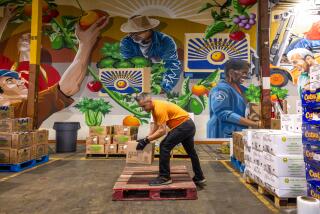Marketing Byproducts Abroad
- Share via
In an appeal to consumers’ sense of economy, a Concord, N.C.-based food company recently announced a cost-cutting measure that involves marketing what would normally be considered food byproducts or waste. There’s nothing revolutionary about the program except for the fact that the food in question is duckling.
Concord Farms Inc. recently publicized that its development of foreign markets for the likes of duckling tongues, wings, feet and gizzards is actually a boon for U.S. consumers, even if in a decidedly indirect way.
As part of this waste disbursement program, the firm also sells duck feathers abroad for processing into down clothing and bedding. The various duck remnants are shipped to Canada, Mexico, several Caribbean nations, Taiwan, Hong Kong and Japan.
The firm claims its enterprising ways and resulting income benefit American consumers by keeping down the supermarket price of whatever is left of the duckling. The birds now sell for between 99 cents and $1.19 per pound nationally, a Concord Farms representative states, making duck meat competitive with both chicken and turkey.
“The reduction in waste and the revenue generated from exports allows the company to pass along savings to . . . the consumer,” the announcement stated.
Apparently, duck producers have taken a page from their counterparts in the hog livestock business. In farm sectors, it’s often said that the wise pig rancher markets “everything but the squeal.” Now, at least in Concord, it’s the prosperous duckling company that sells “all but the quack.”
Waste Futures--Although Concord Farms has taken a somewhat unusual approach in publicizing its success with byproduct sales, the company is not at all alone in squeezing the last penny out of the food processing system. In fact, there is a booming market for whey, the waste remaining after cheese is manufactured.
In 1985, sales of dried whey totaled more than $140 million, according to a report by Frost & Sullivan Inc., a New York-based research firm. By 1989, the company projects, more than 1.5 billion pounds of the substance will be sold annually.
The sales growth is a result of whey’s continuing use in processed foods, often as a protein concentrate. Increasing amounts of the cheese byproduct in the human diet is certainly a switch from just a few decades ago when whey was used primarily as a feed supplement for hogs.
In fact, the study said that the sales growth in whey destined for human food will substantially outpace that portion intended for animal feed.
The report also looked at soy beans and yeast, two non-animal proteins widely used as food additives. The projections for these items are also positive because of the increasing trend toward vegetable and other non-meat protein sources.
Although red meats are certainly having troubles as a result of dietary changes, these high-quality protein sources are not marketed as visible substitutes for beef, pork and lamb. Rather they are inconspicuously included as ingredients in a wide selection of packaged foods ranging from sausages to pastries. Frost & Sullivan reports that the additives are used for fat and water absorption, cost reductions and development of foam properties.
Soy, yeast and whey additives have become so pervasive that the study estimated they can be found in 50% of the foods in the usual American diet.
Better Late Than Never--A little-noticed announcement by the U.S. Department of Agriculture recently described how an agency research team succeeded in developing a low-sodium soy sauce that maintained the flavor of regular brands.
The process was engineered at the USDA’s Agriculture Research Service in Albany, Calif., and involves substituting potassium for much of the sodium present in the popular seasoning for Asian foods. The technique reduces sodium levels by as much as 50% without affecting taste. Medical research has indicated that diets high in sodium may increase the risk of high blood pressure.
Typical soy sauce contains about 439 milligrams sodium per teaspoon. The purported benefit of the USDA process is realized because the potassium not only replaces sodium but also helps purge salt from the body.
There’s only one problem with the USDA’s discovery. There have been low-sodium soy sauces on the market from both American and Japanese companies for some time.
Scent of Jazz--What shapes up as one of the city’s most readily identifiable outdoor concerts will occur July 13 in a parking lot on the west side of San Vicente Boulevard between Beverly Boulevard and Melrose Avenue. The scheduled performers include, among others, pianist Joe Sample, vocalist Ernie Andrews and violinist Papa John Creach.
However, the intended feature attraction of the evening, and the one that is impossible to miss, is the odoriferous bulb: garlic. The fund-raising and scent-creating affair begins at 5 p.m. and benefits the American Red Cross’ Los Angeles Chapter.
About 30 local restaurants will prepare dishes ranging from the typical to the exotic--all featuring a substantial number of cloves. Samples are served for nominal fees above the $5 cost of admission.
The evening inaugurates Garlic Week, which is being celebrated locally for the fourth straight year. In the past, garlic’s distinctive odor has permeated not only the festival’s surrounding area but also the clothes of those in attendance.
Originally, event organizers were a little uncertain whether garlic’s drawing power alone could sustain large crowds. As a result, more and better-known jazz artists have been added over the years. Now, at this stage, the musical portion of the fund-raiser has grown to such an extent that one of the affair’s founders stated, “We have found that our jazz performers have attracted almost as much attention as the garlic.”
For information call (213) 739-5231.
More to Read
Inside the business of entertainment
The Wide Shot brings you news, analysis and insights on everything from streaming wars to production — and what it all means for the future.
You may occasionally receive promotional content from the Los Angeles Times.










